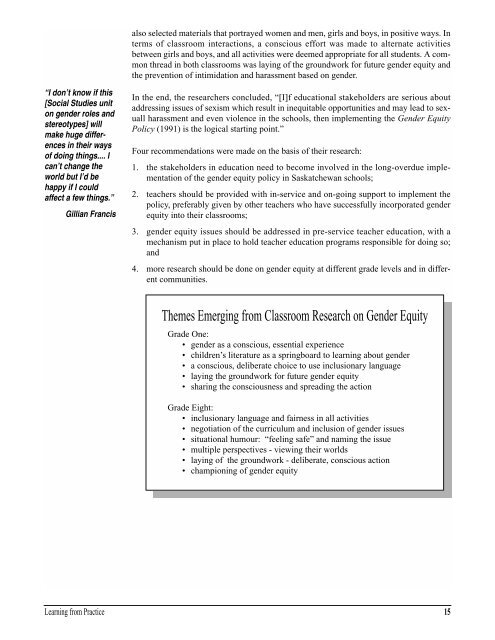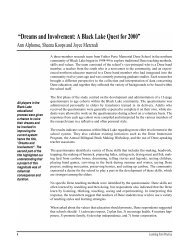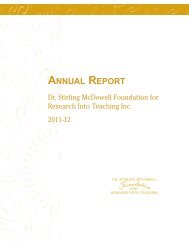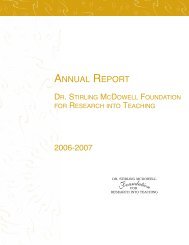Two Teachers’ Classroom Practice of Gender EquityGillian Francis, JoAnn Bergsma, Ling Zhang, and Lorraine CathroIn this study two teacher researchers, Gillian Francis and JoAnn Bergsma, worked collaborativelywith a university-based researcher, Lorraine Cathro, to examine and describehow they understood and lived gender equity in their classrooms. They were assisted byLing Zhang, who compiled a literature review on the subject and contributed to the dataanalysis process.“I hope that at somepoint [my students]have had or will beable to recall experiencesin this gradeone classroom thatwill have an effecton how they feelabout themselvesas males andfemales.”JoAnn Bergsma“How can we bestchampion the causeof gender equity?Living gender equityin the classroomseems a goodstart.”Lorraine CathroIn explaining the intent of their study, the researchers noted that the SaskatchewanDepartment of Education developed Gender Equity Policy and Guidelines forImplementation in 1991. The intent of this policy was to have gender equity becomeembedded in curricula and school practice. However, few Saskatchewan teachers seemedfamiliar with the policy or to have worked to implement it. What seemed to be needed toencourage implementation was a description of how gender equity might be lived in theclassroom by teachers.Specifically, the study outlined two teachers’ understanding of gender equity and howthey translated that understanding into practice, e.g., the development of teaching units,activities and materials. (Sample lessons and lists of materials useful to teachers areincluded in the project’s final report.) It was believed that documenting what actually happensin classrooms as teachers implement gender equity would benefit teachers,administrators, parents, trustees, researchers and students struggling with how genderequity can be lived, rather than just discussed. The study, then, was intended to help fill thegap between the rhetoric of a policy and the reality of implementing that policy in a classroom.A qualitative perspective was used to look at the teachers’ work within the classroom andits context. Data were collected through classroom observations (16-20 hours in eachclassroom), teacher interviews, reflective journals and field notes, and informal meetings.The data were analysed and themes (main ideas which recurred) were identified.The central theme that emerged in both classrooms was the importance of the teachers’role in promoting gender equity. Both teachers found that their own personal understandingof gender and their commitment to work consciously and with determination towardgender equity were keys to implementation. The teachers’ lived experiences were filtersthrough which they continually monitored their own actions. Both teachers becamespokespeople for gender equity: they became involved in conversations, presentationsand committee work in addition to their classroom work.There were deliberate efforts to include gender issues, develop a non-sexist curriculum,and use gender equitable materials in both the classrooms studied. Through use of children’sliterature as a springboard for discussion of gender in issues in the grade oneclassroom and a unit on gender roles and stereotypes in the grade eight classroom, bothteachers helped students identify where sexism exists, and provided activities in whichstudents were encouraged to explore alternatives. Both teachers modelled and monitoredtheir use of inclusionary language while guiding their students to use such language. They14Learning from Practice
also selected materials that portrayed women and men, girls and boys, in positive ways. Interms of classroom interactions, a conscious effort was made to alternate activitiesbetween girls and boys, and all activities were deemed appropriate for all students. A commonthread in both classrooms was laying of the groundwork for future gender equity andthe prevention of intimidation and harassment based on gender.“I don’t know if this[Social Studies uniton gender roles andstereotypes] willmake huge differencesin their waysof doing things.... Ican’t change theworld but I’d behappy if I couldaffect a few things.”Gillian FrancisIn the end, the researchers concluded, “[I]f educational stakeholders are serious aboutaddressing issues of sexism which result in inequitable opportunities and may lead to sexuallharassment and even violence in the schools, then implementing the Gender EquityPolicy (1991) is the logical starting point.”Four recommendations were made on the basis of their research:1. the stakeholders in education need to become involved in the long-overdue implementationof the gender equity policy in Saskatchewan schools;2. teachers should be provided with in-service and on-going support to implement thepolicy, preferably given by other teachers who have successfully incorporated genderequity into their classrooms;3. gender equity issues should be addressed in pre-service teacher education, with amechanism put in place to hold teacher education programs responsible for doing so;and4. more research should be done on gender equity at different grade levels and in differentcommunities.Themes Emerging from Classroom <strong>Research</strong> on Gender EquityGrade One:• gender as a conscious, essential experience• children’s literature as a springboard to learning about gender• a conscious, deliberate choice to use inclusionary language• laying the groundwork for future gender equity• sharing the consciousness and spreading the actionGrade Eight:• inclusionary language and fairness in all activities• negotiation of the curriculum and inclusion of gender issues• situational humour: “feeling safe” and naming the issue• multiple perspectives - viewing their worlds• laying of the groundwork - deliberate, conscious action• championing of gender equityLearning from Practice 15
















